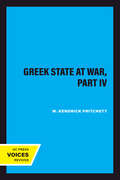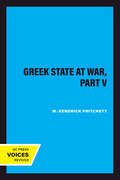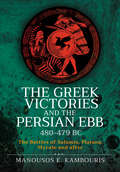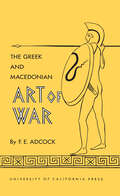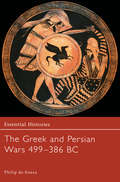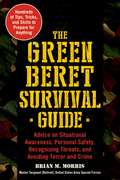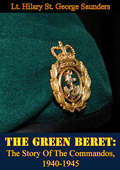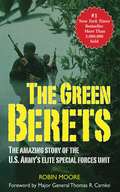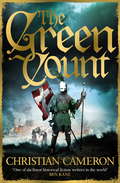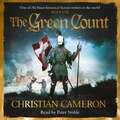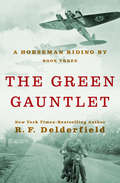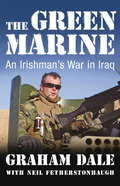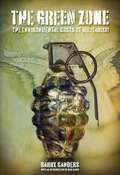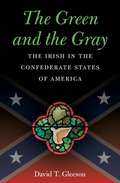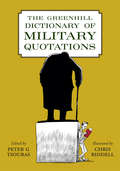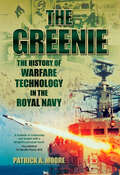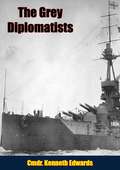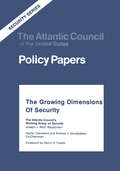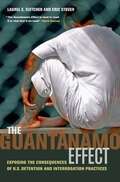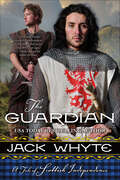- Table View
- List View
The Greek State at War, Part IV
by W. Kendrick PritchettThe volumes of The Greek State at War are an essential reference for the classical scholar. Professor Pritchett has systematically canvassed ancient texts and secondary literature for references to specific topics; each volume explores a unique aspect of Greek military practice.
The Greek State at War, Part V
by W. Kendrick PritchettThe volumes of The Greek State at War are an essential reference for the classical scholar. Professor Pritchett has systematically canvassed ancient texts and secondary literature for references to specific topics; each volume explores a unique aspect of Greek military practice. In Part V he takes up stone throwers, slingers, and booty.
The Greek Victories and the Persian Ebb 480–479 BC: The Battles of Salamis, Plataea, Mycale and after
by Manousos E. KambourisThe dramatic conclusion to this trilogy explains the reversal of fortunes and final defeat of Xerxes’ Persian invasion of Greece; not as unlikely as usually presupposed. The focus is on the successful repulse of the Persian massive armada at Salamis, a resounding naval victory with parallels to the English defeat of the Spanish Armada. Along with the backstage policies and cloak-and-dagger events, the analysis of hard data of naval and military realities and environment shows the reason for this outcome and more so of the closely fought double campaign of the following year that ended the Persian threat. The massive land victory at Plataea that ousted the empire form mainland Greece and crippled its armies, and the amphibious operation at Mycale that destroyed the remnants of the royal Grand Armada and shut the doors to further Persian incursions in Greece is examined in detail. Manousos Kambouris examines in depth the plans, potential, assets and liabilities of the two protagonists to explain command decisions and developments in the field. This is a fine finale to this fresh appraisal of these hugely significant events.
The Greek and Macedonian Art of War (Sather Classical Lectures #30)
by Frank E. AdcockThis informal history traces battle tactics and military strategy from the time of the city-states' phalanxes of spearmen to the far-reaching combined operations of specialized land and sea forces in the Hellenistic Age. The author first describes the attitude of the Greek city-state toward war, and shows the military conventions and strategies associated with it. He then recounts how the art of war gradually evolved into new forms through the contributions of such men as the great commander Epaminondas, Philip of Macedon, his son Alexander the Great, and others. He also discusses the independence of land and sea power, describes the first use of calvary, and tells of the ingenious Greek devices of siegecraft, including the "fifth column."
The Greek and Persian Wars 499-386 BC (Essential Histories #36)
by Philip de SouzaFirst published in 2004. Routledge is an imprint of Taylor & Francis, an informa company.
The Green Beret Survival Guide: Advice on Situational Awareness, Personal Safety, Recognizing Threats, and Avoiding Terror and Crime
by Brian M. MorrisToday's society is one in which we, as individuals, are constantly barraged by the threat of domestic terrorism. The ever-present fear for your safety and the safety of those we love can overwhelm you if you aren’t sure how to protect yourself. Luckily, distinguished combat veteran Brian M. Morris's Green Beret Survival Guide is here to help ease your fears. Using his firsthand knowledge from the field as a Green Beret, Morris concisely outlines the steps that are necessary towards increasing one’s personal safety. Over the course of several chapters, Morris describes the importance of situational awareness, meaning staying alert, being aware of your surroundings, and understanding the reality of threats that you may face in any given situation. An individual with good situational awareness never takes anything for granted and makes security a part of his or her daily routine. By being observant and practicing several different methods of observation, one can avoid falling prey to terrorist, thieves, and other criminals. Using situational awareness as the cornerstone of a personal safety plan, The Green Beret Survival Guide delivers expert advice on preparing you and your loved ones for the worst case scenario.
The Green Beret: The Story Of The Commandos, 1940-1945
by Lt. Hilary St. George Saunders Earl Mountbatten of Burma"I am not worried about the fighting. I know you're fairly bloody-minded. But I want to speak of discipline during the battle.""You must get ashore, if you have to swim, and I hope some of you will return as you'll be very useful for the next show."The words of a Commando officer to his men before they stormed the beaches of Sicily under heavy machine-gun fire sum up the swashbuckling, devil-may-care spirit of the toughest fighting men produced--the Commandos.For their raids and battles far behind enemy lines in France, North Africa, Sicily, Italy and Burma the men in the Green Beret have become a legend.This book shows how this legend was forged.
The Green Berets: The Amazing Story of the U. S. Army's Elite Special Forces Unit
by Robin Moore Thomas R. CsrnkoRobin Moore became one of the first true embedded journalists by training with and fighting alongside the Green Berets in Vietnam. Though fictionalized, his work is an eye-opening exposé of the horrors of the Vietnam War and the basis for the hit John Wayne movie of the same title. Taut, fast-paced, and interspersed with unforgettable accounts of combat, Moore's novel features an American major who goes "native" with Montagnard tribesmen, a courageous Vietnamese girl who poses as a rabid anti-American Communist to capture a murderous Viet Cong officer and the unforgettable acts of courage of soldiers in the field.
The Green Count (Chivalry #3)
by Christian CameronOne of the finest historical fiction writers in the world - Ben KaneAfter the bloody trials of Alexandria, Sir William Gold is readying for a pilgrimage to Jerusalem to ease the burden on his soul. He hopes, too, that the Holy City might allow his relationship with Emile, cousin of the Green Count of Savoy, to develop.But the Roman Emperor of Constantinople has been taken hostage by an unknown enemy, and the Green Count is vital to the rescue effort. It is up to Sir William to secure his support, but he soon finds that his past, and his relationship with Emile, might have repercussions he had not foreseen...Suddenly thrust onto the stage of international politics, Sir William finds himself tangled in a web of plots, intrigue and murder. He must hold true to his chivalric principles, and to his knights, if he is to save the Emperor and survive to tell the tale.
The Green Count (Chivalry #5)
by Christian CameronOne of the finest historical fiction writers in the world - Ben KaneAfter the bloody trials of Alexandria, Sir William Gold is readying for a pilgrimage to Jerusalem to ease the burden on his soul. He hopes, too, that the Holy City might allow his relationship with Emile, cousin of the Green Count of Savoy, to develop.But the Roman Emperor of Constantinople has been taken hostage by an unknown enemy, and the Green Count is vital to the rescue effort. It is up to Sir William to secure his support, but he soon finds that his past, and his relationship with Emile, might have repercussions he had not foreseen...Suddenly thrust onto the stage of international politics, Sir William finds himself tangled in a web of plots, intrigue and murder. He must hold true to his chivalric principles, and to his knights, if he is to save the Emperor and survive to tell the tale.
The Green Count (Chivalry Ser.)
by Christian CameronOne of the finest historical fiction writers in the world - Ben KaneAfter the bloody trials of Alexandria, Sir William Gold is readying for a pilgrimage to Jerusalem to ease the burden on his soul. He hopes, too, that the Holy City might allow his relationship with Emile, cousin of the Green Count of Savoy, to develop.But the Roman Emperor of Constantinople has been taken hostage by an unknown enemy, and the Green Count is vital to the rescue effort. It is up to Sir William to secure his support, but he soon finds that his past, and his relationship with Emile, might have repercussions he had not foreseen...Suddenly thrust onto the stage of international politics, Sir William finds himself tangled in a web of plots, intrigue and murder. He must hold true to his chivalric principles, and to his knights, if he is to save the Emperor and survive to tell the tale.
The Green Gauntlet (A Horseman Riding By #3)
by R. F. DelderfieldIn "The Green Gauntlet", we return to the seven families whose lives are rooted in the green acres of the great farming valley of Shallowford. The time is just at the outbreak of the Second World War, when the valiant pilots of the RAF are locked in combat with the Luftwaffe in the skies above Devon and England stands imperiled as never before by the dark shadow of Nazi invasion. The hero again is Paul Craddock -- older, wiser, but still fiercely dedicated to his land, to his children and grandchildren, to his tenants and to the vanishing way of life they represent.
The Green Gauntlet (A Horseman Riding By #3)
by R. F. DelderfieldR. F. Delderfield concludes his bestselling A Horseman Riding By saga of twentieth-century England with a novel that follows the Craddock family through the end of World War II and the challenges of a new eraPaul Craddock&’s village in rural Devon has endured despite the heartbreak and sorrows of war. The landowner and his family have also known their share of loss. But now, as England struggles to rebuild in the aftermath of World War II, he and his wife, Claire, and their children confront new perils. With his livelihood threatened by emerging property laws and his family divided over the future of his beloved Shallowford estate, Craddock struggles to preserve his legacy. For his sons and daughter, the fifties and sixties will be a time of discovery and change that will resonate in the lives of their own children. The final novel in Delderfield&’s magnificent trilogy pays tribute to the courage and unflagging optimism of British villagers trying to keep step with modern times even as they cling to the traditions of a bygone world.The Green Gauntlet is the third novel in R. F. Delderfield&’s saga A Horseman Riding By, which begins with Long Summer Day and continues with Post of Honour.
The Green Glass Sea
by Ellen Klages(back of book) It is 1943, and almost eleven-year-old Dewey Kerrigan is on a train to New Mexico, where she will live with her father. She doesn't know where in New Mexico, exactly; the corporal who took her to the station can't tell her. It's wartime, and so many things are secret. Soon she arrives at a town that- officially- doesn't exist. It is called Los Alamos, and it is abuzz with activity, as famous scientists and mathematicians from all over America and Europe- Dewey's father among them- work on the biggest secret of all, something everyone calls only "the gadget." Over the next few years, Dewey gets to know those scientists, starts working on her own mechanical projects, and locks horns with Suze Gordon, a budding artist who is as much of a misfit as she is. None of them- not J. Robert Oppenheimer, the director of the Manhattan Project; not the mathematicians and scientists; and least of all, Dewey and Suze- know how much "the gadget" is about to change their lives, and the world. Ellen Klages's voice is remarkable, fresh, and without pretense. You will be swept away by The Green Glass Sea.
The Green Marine: An Irishman's War in Iraq
by Neil Fetherstonhaugh Graham DaleDubliner Graham Dale, an IT specialist living in Texas, was working as a volunteer with a fire department when he heard that an airplane had hit the World Trade Centre in New York. As the tragic events unfolded before his eyes, he suddenly realised that he could no longer remain a spectator in the face of this appalling atrocity. There and then he made a decision that was to affect the rest of his life; he drove to the nearest Military Recruitment Centre and enlisted in the US Marines.After surviving months of 'constant mental and physical torture' in the notoriously tough 'Marine Boot Camp' in San Diego, he joined the ranks of one of the most elite branches of the United States military and two years later found himself patrolling the dangerous wastes of the western desert in war-torn Iraq. Throughout his deployment in Iraq, Dale kept a daily journal to give us an astonishing, true account of one man's fight in the frontline of America's 'War on Terror'. Told with brutal honesty, he gives us a unique and rare insight from an Irishman, fighting for a foreign military in a very foreign land.
The Green Marine: An Irishman's War in Iraq
by Neil Fetherstonhaugh Graham DaleDubliner Graham Dale, an IT specialist living in Texas, was working as a volunteer with a fire department when he heard that an airplane had hit the World Trade Centre in New York. As the tragic events unfolded before his eyes, he suddenly realised that he could no longer remain a spectator in the face of this appalling atrocity. There and then he made a decision that was to affect the rest of his life; he drove to the nearest Military Recruitment Centre and enlisted in the US Marines.After surviving months of 'constant mental and physical torture' in the notoriously tough 'Marine Boot Camp' in San Diego, he joined the ranks of one of the most elite branches of the United States military and two years later found himself patrolling the dangerous wastes of the western desert in war-torn Iraq. Throughout his deployment in Iraq, Dale kept a daily journal to give us an astonishing, true account of one man's fight in the frontline of America's 'War on Terror'. Told with brutal honesty, he gives us a unique and rare insight from an Irishman, fighting for a foreign military in a very foreign land.
The Green Zone: The Environmental Costs of Militarism
by Barry SandersEnvironmentalism—it’s the word on everyone’s tongue. Reusable shopping bags, hybrid cars, and green home energy solutions allow us to reduce our carbon footprint, but it’s only the tip of the quickly melting iceberg. In the midst of the movement to save the earth, The Green Zone presents a sobering revelation: until we address the attack that the US military is waging on the global environment, the things we do at home won’t change a thing. This new investigation by author and journalist Barry Sanders examines in detail the environmental impact of US military interventions overseas. In a period of unprecedented scrutiny surrounding the social and economic impacts of the defense policies of the US government, Sanders explores a completely different aspect of the situation and positions military activity as the single-greatest contributor to the worldwide environmental crisis, looking at everything from fuel emissions to radioactive waste to defoliation campaigns. Based primarily on research culled from documents released or leaked by the military itself, The Green Zone is the first book to provide a comprehensive examination of the relationship between militarism and ecological destruction. Includes a powerhouse introduction by urban theorist Mike Davis.
The Green and the Gray
by David T. GleesonWhy did many Irish Americans, who did not have a direct connection to slavery, choose to fight for the Confederacy? This perplexing question is at the heart of David T. Gleeson's sweeping analysis of the Irish in the Confederate States of America. Taking a broad view of the subject, Gleeson considers the role of Irish southerners in the debates over secession and the formation of the Confederacy, their experiences as soldiers, the effects of Confederate defeat for them and their emerging ethnic identity, and their role in the rise of Lost Cause ideology. Focusing on the experience of Irish southerners in the years leading up to and following the Civil War, as well as on the Irish in the Confederate army and on the southern home front, Gleeson argues that the conflict and its aftermath were crucial to the integration of Irish Americans into the South. Throughout the book, Gleeson draws comparisons to the Irish on the Union side and to southern natives, expanding his analysis to engage the growing literature on Irish and American identity in the nineteenth-century United States.
The Greenhill Dictionary of Military Quotations
by Chris RiddellA &“massive [and] valuable&” collection of quotes about war from soldiers, commanders, strategists, and others (The Spectator). This volume brings four thousand years of military history to life through the words of more than eight hundred diverse personalities—Napoleon, Machiavelli, Atatürk, Che Guevara, Rommel, Julius Caesar, Wellington, Xenophon, Crazy Horse, Wallenstein, T.E. Lawrence, Saladin, Zhukov, Eisenhower and many more—to build a comprehensive picture of war across the ages. Broken down into more then 480 categories, including courage, danger, failure, leadership, luck, military intelligence, tactics, training, guerrilla warfare and victory, this definitive guide draws on the collected wisdom of those who have experienced war at every level. From the brutality and suffering of war, to the courage and camaraderie of soldiers, to the glory and exhilaration of battle, these quotes offer an insight into the turbulent history of warfare and the lives and deeds of great warriors. &“A massive compilation casting light not only upon the pain, suffering and sheer insanity of war, but also upon the unique comradeship and exhilaration of battle . . . this is a valuable addition to the literature of reference.&” —The Spectator
The Greenie: The History of Warfare Technology in the Royal Navy
by Patrick A MooreIn the Royal Navy vernacular, the term 'greenie' describes the officers and ratings responsible for the electrical engineering functions of the fleet. Electrical engineering has 'driven' the Royal Navy for far longer than one might imagine, from solving the problem of magnetic interference with the compass by the ironclad early in the 20th century onward. Author Commander Moore traces the development of technology from 1850 to today's integrated micro computers that control almost every aspect of navigation, intel, and strike capacity. At the same time, he describes how the Navy's structure and manpower changed to accommodate the new technologies, changes often accelerated in wartime, particularly in World War II. Without the full cooperation of naval establishments and organisations and various public and private museums and manufacturers, this work would have been impossible to produce. Written in an anecdotal, narrative style but with a complete mastery of the science itself, it will appeal not only to those interested in the history of the Royal Navy but also those many thousands, past and present, who can claim the honour of calling themselves one of the Greenies.
The Grey Diplomatists
by Cmdr. Kenneth EdwardsThe Grey Diplomatists of the title were the sea grey battleships, cruisers and destroyers of the Royal Navy, who sailed around the globe to keep the Pax Britannica in the fraught years between the First and Second World Wars. Although Europe had exhausted itself after the hecatomb of World War I there were still many hotspots of conflict around the globe, and the ships of the Royal Navy were despatched to keep the peace and protect British interests. From the civil war in Russia, unrest in Turkey, revolt in Cyrus and rising tensions between France and Italian colonial possessions in Africa, the sea grey fleets of the Royal Navy attempted to diffuse these conflicts. Written by Commander Kenneth Edwards who was serving in the fleets at the time this volume provides a view a forgotten period between the Great Wars.
The Growing Dimensions of Security: The Atlantic Council's Working Group on Security
by D. C. WashingtonFirst Published in 2018. Routledge is an imprint of Taylor & Francis, an Informa company.
The Grub Street Dictionary of International Aircraft Nicknames, Variants and Colloquial Terms
by John HortonA dictionary which provides the international aircraft nicknames, colloquial terms, etc...
The Guantánamo Effect: Exposing the Consequences of U. S. Detention and Interrogation Practices
by Laurel E. Fletcher Eric StoverThis book, based on a two-year study of former prisoners of the U.S. government's detention facility at Guantaacute, Cuba, reveals in graphic detail the cumulative effect of the Bush administration's "war on terror."
The Guardian: A Tale of Scottish Independence (The Guardians Series #3)
by Jack Whyte“A compelling, fact-based read filled with action, politics and personality” from the USA Today–bestselling author of Robert the Bruce (Historical Novel Society).Some men strive for greatness. And some men find themselves thrust into the role of their nation’s saviors. Such are the two heroes who reshaped and reconfigured the entire destiny of the kingdom of Scotland. Wallace the Braveheart would become the only legendary, heroic, commoner in medieval British history; the undying champion of the common man. The other, Robert Bruce, earl of Carrick, would perfect the techniques of guerrilla warfare developed by Wallace and use them to create his own place in history as the greatest king of Scots.In the spring of 1297, the two men meet in Ayr, in the south of Scotland, each having recently lost a young wife, one in childbirth and the other by murder. Each is heartbroken but determined in his grief to defy the ambitions of England and its malignant king, Edward Plantagenet, whose lust to conquer and consume the realm of Scotland is blatant and unyielding. Their combined anger at the injustices of the invading English is about to unleash a storm in Scotland that will last for sixteen years—and destroy England’s military power for decades—before giving rise to a new nation of free men.
